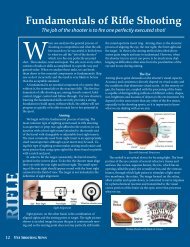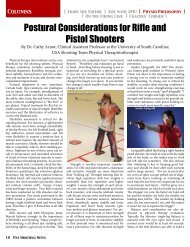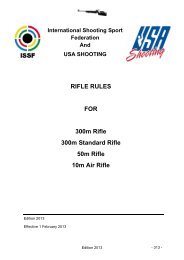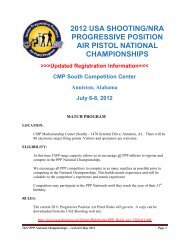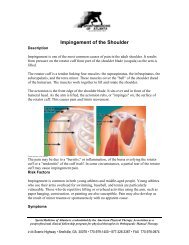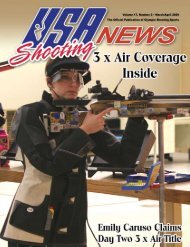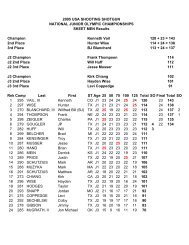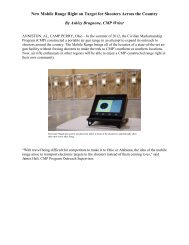January/February 2011: Volume 19, Number 1 - USA Shooting
January/February 2011: Volume 19, Number 1 - USA Shooting
January/February 2011: Volume 19, Number 1 - USA Shooting
Create successful ePaper yourself
Turn your PDF publications into a flip-book with our unique Google optimized e-Paper software.
Posture & Position<br />
Many people ask how to shoot the<br />
same scores in matches as they do in<br />
training. All shooters have the ability<br />
to fire a ten, and elite shooters train<br />
to shoot multiple tens. In practice,<br />
do you shoot solid scores, efficiently duplicating the<br />
tens process, and then enter a match and walk away<br />
discouraged because the score you shot is much lower<br />
than your practice scores?<br />
Don’t worry, this has happened to everyone. The<br />
label is sometimes given to these people as “practice<br />
champions.” All shooters experience this frustration<br />
at some time during their shooting career. Many years<br />
ago, I was at a mental management seminar by the<br />
sports psychologists of West Point.<br />
They discovered that I had the technical skill<br />
(gained from training), but that I didn’t trust my ability.<br />
I needed to develop a trusting<br />
mind set. When we train, we<br />
build the subconscious and show<br />
it how to shoot a ten. When we<br />
train a lot, we reinforce how to<br />
shoot a ten. When we go to a<br />
match, we do not trust that what<br />
we have practiced is correct; thus the outcome does not<br />
match the training scores. While training, we must also<br />
remember to build self-confidence and trust.<br />
When training, it is best to start simple and<br />
slowly increase the difficulty. First, do you know how<br />
to shoot a ten? Second, can you duplicate the process<br />
of shooting a ten? Last, establish a goal of a score that<br />
would be comfortable for you to attain in a match, and<br />
decide what you have to shoot to accomplish that goal.<br />
Shoot the match, and try to hit the same goal that you<br />
have already set and attained during training. After<br />
the match, if you hit your mark, then raise the goal a<br />
little. Practice achieving that goal and feel comfortable<br />
attaining it, and then relax at a match and duplicate<br />
that goal and so on. Some people make the mistake of<br />
making a higher goal during a match because it counts<br />
in a match.<br />
The goal in a match is to accomplish what you<br />
know that you can already do and have already proven<br />
to yourself. For example, if you are taking beginning<br />
physics, don’t expect to take a test on solving the theory<br />
of relativity. It is not going to happen at that point of<br />
your studies. One day, you will be able to accomplish<br />
that, but not at this point of your mental development.<br />
Therefore, your match goal should be somewhere<br />
around what you shoot in practice. I have met people<br />
When training, we must<br />
also remember to build<br />
self-confidence and<br />
trust.<br />
that will shoot around 530s or 540s in practice, and<br />
then have the goal of winning nationals or making the<br />
Olympic team. They are creating unnecessary stress<br />
because their bodies cannot accomplish this at that<br />
point in their career. Your goal should be a challenge,<br />
but still within reach. Accomplish it a couple of times in<br />
practice so you know that if you just do A, B and C, then<br />
you will create a result that you can be happy with.<br />
<strong>Shooting</strong> is an individual sport, so set individual<br />
goals. Everyone wants to win, but only one person<br />
can. If you set attainable goals for yourself, then there is<br />
not such an urge within the match that “I have to start<br />
shooting better” or “I sure have shot a lot of tens. I am<br />
going to win at this rate.” You are just going to the match<br />
to accomplish what you have done everyday in practice.<br />
You know what you have shot in practice, so just relax<br />
and try to accomplish this result<br />
in the match. Push the envelope<br />
during training, and then shoot a<br />
match inside your comfort zone.<br />
The goal should be<br />
performance oriented rather than<br />
outcome oriented. For example,<br />
I aim to shoot 16 tens out of every 20 shots instead of<br />
only shooting 98s. This goal offers more wiggle room<br />
and is easier on the mind. The first benchmark leaves<br />
you room to make a mistake, yet it also gives you a<br />
chance to improve. The first example also takes overall<br />
score out of your mind and brings you back to shooting<br />
one shot at a time.<br />
Trusting yourself when you shoot a match will<br />
make your match scores and your training scores<br />
come out closer together. Make it challenging, but not<br />
something that you have never done before. When<br />
you shoot with trust, then when you are performing at<br />
exceptional levels, you know that there are highs and<br />
lows in your shooting.<br />
Moreover, when you are shooting an excellent<br />
match, then you can calm yourself by saying, “I know<br />
for every up there is a down. I will keep it up as long<br />
as I can. I am going to shoot somewhere in this range,<br />
because this is what I have been training.” If there is a<br />
low, then you know, “I am down right now, but I have<br />
done this before. It will come back up if I apply the<br />
techniques that I have drilled to shoot a ten.” When<br />
you attend your next match, set your goal, forget your<br />
nervousness and learn to trust yourself and trust your<br />
training.<br />
■ Sgt. 1st Class Daryl Szarenski<br />
www.usashooting.org 11<br />
Pistol<br />
jan feb <strong>2011</strong>.indd 11<br />
1/3/<strong>2011</strong> 10:45:59 AM





